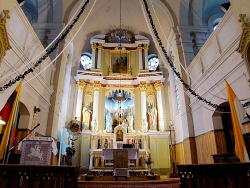Going to the coast, from e.g. Vilnius, you pass through Kaunas and then down to the area along river Nemunas
ďPanemuneĒ in Lithuanian. Because the river was the old border with Poland, and there are mountains on the Lithuanian
side. the are lots of borderline fortresses there. The are also a couple of castles built for romantic purposes
by rich people in the 18:th and 19:th centuries. The Soviets had them decay, but nowadays they are more or less
restored, for tourism and as museums. There is a large road along the river and a small one on top of the mountain
ridge. Thatís the one to take. These images are in the order that the towns appear along Nemunas in the Jurbarkas
district, as seen from Kaunas.
Seredzius and Vilkija
|
|
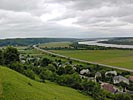
|
Panemune is dominated by the river Nemunas. A view towards Kaunas. |
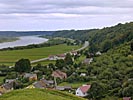
|
The view from Vilkija (Wolf Town) right where the motorway from Kaunas bends and goes along Nemunas. |
The view of Panemune along the whole ridge is fantastic, wherever you decide to stop and watch it. |
| Seredzius is a very small village that you might just
swoosh through. Donít do that. Rather, have a stay and look at the church. It doesnít look like much on the outside,
but the inside has a bit to offer church-ophiles. |
|

|
The church of St. John was built by the priest P. Rudokas in the years 1897-1913... |
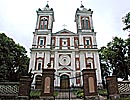
|
as a replacement for earlier churches that had either burnt or been flooded by Nemunas, which was unregulated in
that time. Nowadays there is a dam just before Kaunas preventing any floods. At the same time it is thought to
be the greatest threat to Kaunas. One little bomb and the whole of Kaunas is washed away. Well, then the churches
were at the river front, and the real solution was to move them to the top of the mountain ridge. |
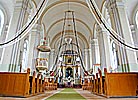 |
The church is very majestic inside for being a small country church. |
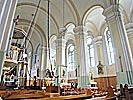
|
We are told that a priest in Seredzius who encouraged people to take part in the revolution against the Tsar in
1863 was sent off to Siberia for 10 years, and never came back. |
|
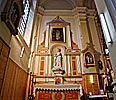
|
Left side altar. |
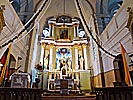
|
The altar is grand and adorned with the Vatican and Lithuanian flags, but I detest seeing fluorescent tubes in
a church... |
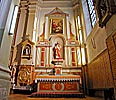
|
Right side-altar. |
Veliuona
|
| The church in Veliuona was founded by Vytautas the Great
in 1421 on an earlier pagan temple. The Crusaders crusading in the area in the 15:th century destroyed the temple
and built a tower with a Christian cross at the same place. Remember that Lithuania was only Christened in the
very late 1400ís. Vytautas continued the Crusadersí work and built the church beside the tower. The tower remained
for a long time but the cross was blown off in storm in 1930. |
|

|
This one doesnít look exactly modern. |

|
The plaster is coming off in big chunks on the outside. The congregation is probably poor. Thereís some cables
going here and there. |

|
In a view from behind we see that the church hasnít been deformed with time and gone round-ish like other old buildings
tend to do. |
|

|
Inside, itís as nice as anything. |

|
Here, things are really shining. Unfortunately we couldnít get in. These are pictures made through the wrought-iron
gate. |
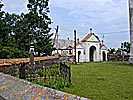
|
The church-yard is rather spares, there is nothing to muse about. But the view towards the river is extraordinary. |
|

|
But they do have a chapel with the holy Virgin. |

|
A memorial over Grand Duke Vytautas that was miraculously left intact by the Communists stands in a good spot in
the middle of the village. ďDLK VytautasĒ means Didysis Lietuvos Kungiaistis Vytautas, the Lithuanian Grand Duke
Vytautas. |
Raudone and Panemune
|
| Raudone Castle means something like The red castle, and
the red brick is fitting. The place has a long history, beginning with a royal manor in the 18:th century. By the
end of the 18:th century the Prussian Cristin Kirstenstein built a renaissance castle at the place. His grandson
became finance minister for the Lithuanian grand duke, went to live in Raudone and the castle was well off. The
castle has burnt many times and been rebuilt, probably not with the exact same appearance. It is now a first grade
school During the Second World War the Germans used it as a concentration camp for women with venereal disease.
Oh, those Germans were so inventive. |
|
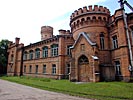
|
Here is one of the sides. It doesnít look very inviting. The black windows do look a bit scary. |
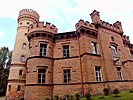
|
One can imagine what the imprisoned women felt like. |
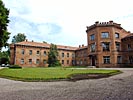
|
Anyway the yard was nice and well kept. It cost 5 litas to get in, but the museum had very little in the way of
ohís and ahís. |
|

|
The castle does look rather cool, though. It is a real princess castle, with towers and pinnacles, and bulwarks. |
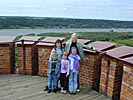
|
From the top of the 35-metre tower the view is good. Of course you also see river Nemunas. |
This is some school! There is also an old mill on the grounds. |
| Panemune Castle in the town of Vytenai was built between
1604-1610, not primarily for defence, but rather because it was so cool to have your own knightís castle. There
are lots of styles, such as renaissance, baroque and classicism. |
|
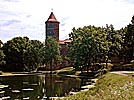
|
The castle is surrounded by a beautiful park with five dams and waterfalls in between. |

|
This is what it looks like from the entrance. |

|
Itís easy to see the main wind direction. |
|

|
A picture from the rear of the castle. You can see itís in great need of restoration. Peeping over the fence shows
the same thing. But it is extremely majestic. |
All around the castle are man-made lakes and waterfalls, with beautiful houses on little islands.
They are not connected to the castle as such, but well worth a walk around the grounds.
|
